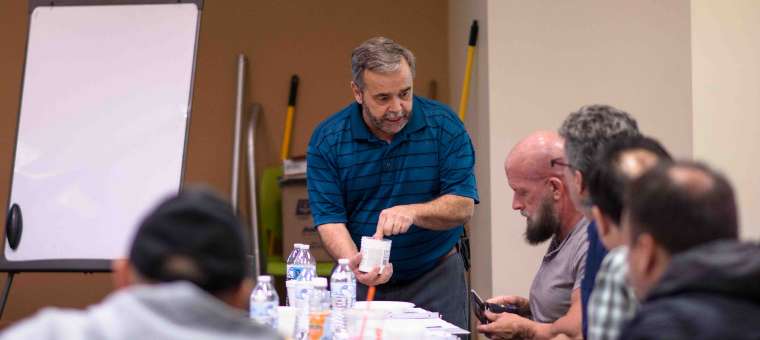Moisture Meter Selection Guide: How to Choose the Right Moisture Meter / Hygrometer
Moisture and humidity can only be properly detected and measured by the right equipment, notably the right meters. Meters offer a true picture of the source and extent to which moisture has impacted a structure.
All restoration professionals who handle water damage jobs MUST have a complete set of moisture meters and accessories in their arsenal to make sure they’re getting the job done right.
Types of Meters and Accessories
• Non-Penetrating Meters
Non-penetrating meters are non-invasive and don’t cause any damage to a structure. They have a series of flat sensors on the bottom that measure the moisture levels between them. They’re an excellent tool for comparing the affected area to either a non-affected area or a dry standard.
• Penetrating Meters
Penetrating meters have a series of pins that probe into a surface and give you a visual display of moisture content. They tend to be more accurate than non-penetrating meters. Most come with deep wall probes for finding trapped moisture. Some also have data logging capability.
• Hydrosensors
Hydrosensors are invasive meters that are great for mapping out how far moisture has migrated from the source (Ex: a sump-pump backs up, so you need to know if the water has migrated to the far corner of the room.) Most will give you an audible signal letting you know where the moisture has migrated in the carpeting and carpet padding. Hydrosensors are not designed for drywall or other building materials.
• Thermo-Hygrometers
Thermo-hygrometers help you determine whether the environment is set up to dry by examining environmental conditions of affected and non-affected outside and inside conditions. Thermo-hygrometers measure both the temperature and relative humidity in the air. These are excellent tools to help you determine if your dehumidifier is working properly. Some meters also offer dew point calculation along with GPP (Grains Per Pound).
• Slide Hammers
This is an accessory that is used in conjunction with a penetrating meter to determine if moisture has migrated to the wood sub-flooring. The slide hammer has Teflon-coated pins that can be driven into the sub-flooring. The pins on the slide hammer will only detect moisture at the tips and not on the side—this lets you be sure you’re reading the moisture content of the sub-flooring and not the carpet or padding along the sides of the pins. This tool is great for determining how deep water has penetrated into the sub-floor, sill plates and hard wood.
Using Moisture Meters on the Job
- Discuss the extent of the damage with the customer to determine a location that is dry to establish a baseline reading. This benchmark will provide the contrast you need to assess the degree of moisture in the home’s suspect areas. Note: Make sure that the materials you test to establish your benchmark are the same as the affected materials you need to test.
- Next, test the area where the most moisture has accumulated. There are always exceptions, but typically, you will find most of the moisture in your test area to have collected at the bottom of the wall, so begin your investigation there.
- Compare the reading you get with the one you took at the building’s dry site. Continue to explore the area by starting at the wettest spots, moving the meter out and up to get a rough idea of how much of the area has been affected by the water.
- Use colored tape to cordon off the boundary of the damaged area. According to the EPA, a wet spot that’s less than 10 feet square isn’t considered to be a major problem. (Though your customer may see it differently.)
- Begin writing your “scope of work” report for the job. If you don’t yet have a documentation format, we urge you to develop one. Your customer, insurance agent, and adjustor need thorough documentation for claims, so be sure to be meticulous in your record keeping.
- As you begin the drying process, make sure that you continually use your meters to test the area. You need to make sure that your drying efforts are being effective. Only when you have verified with your meters that the affected area is completely dry can you consider the job complete.
Special Precaution: If the water damage you’re assessing is 72 hours or older, it’s quite likely that mold and/or bacteria may have begun to develop. Mold remediation is a serious job, so make sure that you have the right training personal protective gear, equipment and chemicals. If mold is not properly removed, it can cause severe, even fatal, illnesses in building occupants and result in devastating lawsuits against your company.
Tip for New Restoration Contractors
Most inexperienced restoration contractors will focus on the drywall, carpet, and padding when on a job site and forget to pay attention to the subfloor, sill plates, and plaster. Remember, even though the drywall and carpeting feel dry to the touch, there is most likely a great deal of moisture still hiding within the structure.If the hidden is not removed quickly, it can cause structural instability and promote the growth of mold and mildew. These are the most dangerous consequences of flood damage, and should be at the forefront of your mind at all times.
You should use moisture meters to help determine how much equipment is required, disclose hidden pockets of moisture, ensure you are drying the structure effectively, and validate that the structure is dry.
Check Out our Complete Selection of Meters and Sampling Equipment



